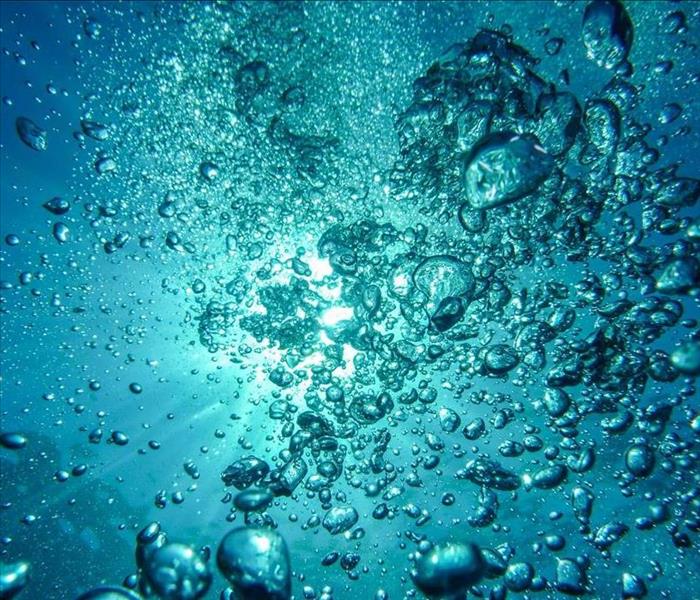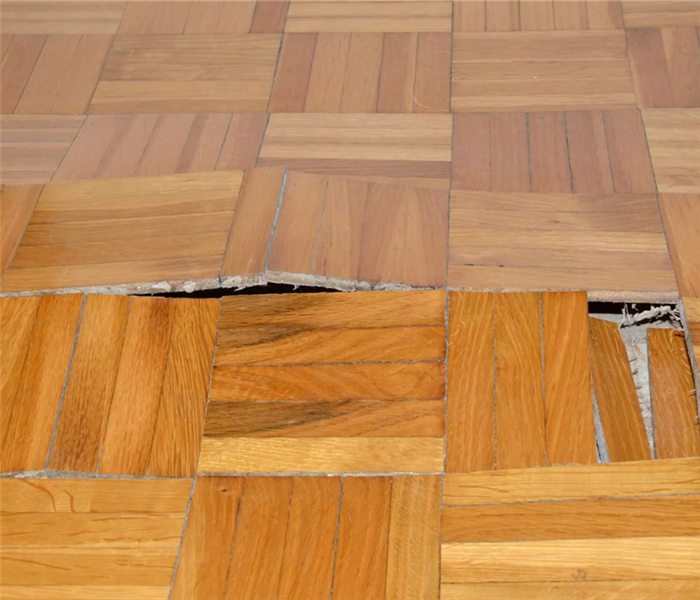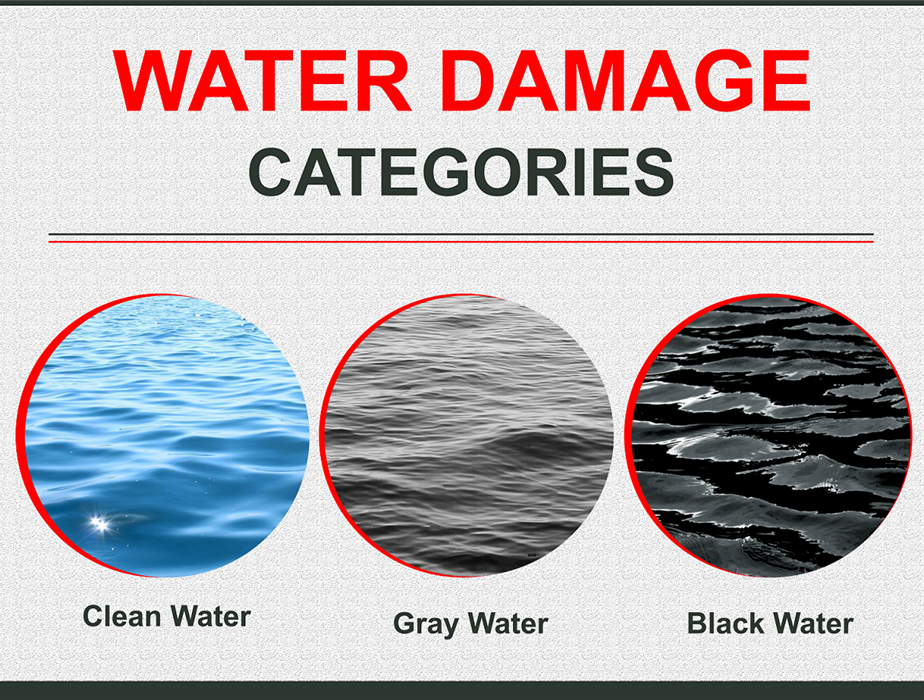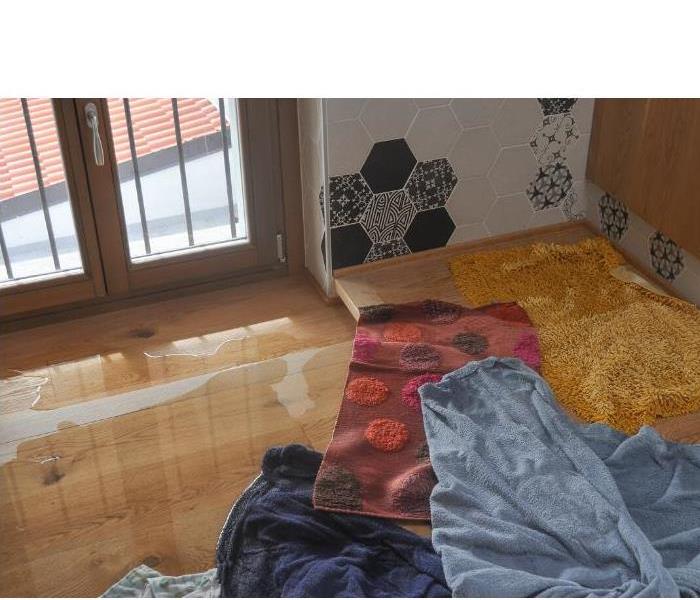Archived Water Damage Blog Posts
The Importance of Removing Cabinets When Drywall is Wet Behind Them After Water Damage
11/6/2024 (Permalink)
Water damage can be one of the most destructive and stressful situations a homeowner can face. Whether from a burst pipe, a leaky roof, or an appliance malfunction, water can infiltrate the home, affecting not just the visible areas but hidden spaces behind walls, cabinets, and floors. One of the most critical actions to take when dealing with water damage is properly assessing the impact on structural elements like drywall—and in many cases, that may include removing the cabinets.
Here’s why removing cabinets to access and dry out wet drywall is crucial to restoring your home effectively.
1. Preventing Mold Growth
When water saturates drywall, it creates an environment conducive to mold growth. Mold can begin to grow within 24-48 hours of exposure to moisture, potentially spreading to other areas of your home. If the drywall behind the cabinets is not dried out properly, it may become a breeding ground for mold that could affect your health and lead to costly remediation down the line.
By removing the cabinets, technicians can access and thoroughly dry the affected drywall, reducing the risk of mold growth and ensuring that your home is safe from long-term damage.
2. Thorough Drying of Hidden Areas
Water damage often affects areas that are not immediately visible, such as behind cabinets. If these hidden spaces are not adequately dried, the moisture can linger, causing further damage to the structural integrity of the home. Wet drywall can weaken over time, leading to the potential for further structural issues, such as sagging or collapse.
Removing the cabinets allows for proper inspection and drying of these areas, preventing future complications and ensuring that all affected materials are fully restored.
3. Ensuring Proper Remediation
The goal of water damage remediation is not just to clean up the visible damage, but to prevent further issues that may arise from unseen damage. If the drywall behind cabinets remains wet, there’s a good chance that the problem will persist, and the remediation will be incomplete. This can lead to the need for future repairs, additional costs, and ongoing issues.
By removing the cabinets and ensuring that the drywall is completely dry, you can rest assured that the restoration is done correctly the first time. This thoroughness will help minimize the chances of needing additional repairs down the road.
4. Protecting Your Cabinets
While it may seem counterintuitive to remove cabinets, doing so can actually protect them in the long run. Many cabinets are made from materials that can warp, swell, or deteriorate when exposed to water for extended periods. Even if the damage to the cabinets seems minimal, water behind them can cause hidden damage that compromises their integrity.
Removing the cabinets allows for proper drying of both the drywall and the cabinets themselves. By addressing the issue proactively, you may be able to salvage the cabinets and avoid the need for costly replacements.
5. Preserving Your Home's Value
Water damage that is not properly addressed can lead to long-term problems that diminish the value of your home. If mold, rot, or structural issues develop, it could affect the overall marketability of your property. Ensuring that all areas of the home, including those behind cabinets, are thoroughly dried and restored helps preserve your home’s value and prevents further complications from impacting your investment.
Conclusion
When dealing with water damage, it’s essential to be proactive in addressing all affected areas, including those hidden behind cabinets. Removing the cabinets allows for proper inspection, drying, and remediation of the drywall, helping to prevent mold growth, structural damage, and future repairs. Whether you're dealing with a small leak or significant water damage, taking these necessary steps will ensure a more complete restoration and protect your home for years to come.
If you’re facing water damage in your home, it’s always best to consult with professionals who can assess the situation and handle the necessary remediation steps—ensuring that your home is restored to its pre-damaged condition.
Understanding the Importance of Subrogation in a Water Damage Situation
11/6/2024 (Permalink)
Water damage can be one of the most costly and disruptive issues a homeowner or business owner can face. Whether it’s due to a burst pipe, a leaking roof, or a natural disaster, water damage can cause extensive harm to property, belongings, and structures. When dealing with such damage, many people turn to their insurance to help cover the costs of repairs and restoration.
However, insurance companies do not always bear the full cost of claims without seeking reimbursement. This is where subrogation comes into play. Understanding subrogation can help you better navigate the complexities of insurance claims after water damage and ensure that you're getting the coverage you're entitled to.
What is Subrogation?
Subrogation is the legal process by which an insurance company seeks reimbursement from the party that caused the damage after they have paid out a claim to the insured. In the context of water damage, subrogation typically occurs when your insurance company covers the costs of water damage to your property, but later attempts to recover those costs from the responsible party or their insurance.
For example, if the water damage was caused by a neighbor’s overflowing bathtub, your insurance company might pay for the repairs to your home. Then, your insurance company would pursue subrogation by either recovering the money from the neighbor’s insurance or directly from them.
Why is Subrogation Important in Water Damage Situations?
Here are a few key reasons why subrogation is essential in water damage cases:
1. Protects Your Financial Interests
Subrogation helps to ensure that the person or entity responsible for the water damage ultimately bears the financial burden, not you. Even if your insurance policy covers the damages initially, subrogation ensures that your insurance company attempts to recover the costs from the responsible party. This helps keep your premiums from rising unnecessarily due to the claim.
For example, if a contractor's mistake led to a plumbing failure that caused water damage in your home, subrogation gives your insurer the ability to seek recovery from the contractor or their insurance. This can help protect your long-term financial interests by preventing you from having to pay for the damages that were not your fault.
2. Keeps Insurance Premiums in Check
If you file a water damage claim, your insurance provider will likely increase your premiums in the future to recoup their costs. Subrogation helps insurance companies recover funds from the responsible party, which can help reduce the impact on your premiums. Essentially, it helps prevent the domino effect of premium hikes that would occur if the insurance company couldn't recover the funds.
By pursuing subrogation, insurance companies are able to offset the claims they pay out, which, in turn, helps keep rates more affordable for all policyholders.
3. Ensures Accountability
Subrogation holds the responsible party accountable for their actions. In water damage cases, this could mean the property owner whose faulty plumbing caused a flood, or a contractor who made an error during construction. By pursuing subrogation, insurance companies enforce the principle that if someone is at fault for damages, they should pay for the consequences.
This not only helps the insured recover their losses, but it also serves as a deterrent to prevent negligence or poor practices that could lead to water damage in the future.
4. Helps Expedite the Claims Process
Subrogation can also streamline the claims process for the insured. Once your insurance company has paid for the water damage repairs, they can begin the process of seeking reimbursement from the responsible party or their insurer. In cases where subrogation is successful, you may find that your insurance company settles the matter quickly, which can help you avoid any delays in your restoration process.
It’s a way for insurers to recover costs without dragging the insured into prolonged litigation, allowing you to focus on getting your home or business repaired.
5. Provides a Safety Net for Everyone Involved
Subrogation not only protects you as a policyholder, but it also creates a safety net for the responsible parties. By resolving the issue through subrogation, your insurance company can recover the costs without causing undue financial burden on the individual or business at fault. Instead of directly suing for damages, which can take time and resources, subrogation provides an alternative means to seek reimbursement through the appropriate channels (insurance companies).
This often helps speed up the process and reduces potential conflict, as it allows all parties to rely on the terms and coverage of their insurance policies.
6. Subrogation and Water Damage Lawsuits
In some cases, subrogation can lead to lawsuits if the responsible party is uncooperative or their insurance denies liability. For instance, if a neighbor's negligence causes significant water damage to your home, your insurer may try to settle the matter through subrogation, but if that doesn't work, legal action may follow. This can help ensure that justice is served and that the individual or company responsible for the damage pays their fair share.
However, it’s important to note that legal action may take time, and the process can be complex. Subrogation is often the first step to resolving these types of disputes, but it doesn't always eliminate the possibility of a lawsuit.
Conclusion
Subrogation plays a crucial role in the aftermath of water damage, protecting both the insured and the insurer. By ensuring that the responsible party ultimately covers the costs of the damages, subrogation helps to safeguard your financial interests, keeps premiums from rising, and enforces accountability. If you ever face water damage, understanding how subrogation works—and how it can benefit you—is an important part of the claims process.
If you’re dealing with a water damage situation, consult with your insurance provider and consider working with a restoration company to ensure that all damages are properly documented, and subrogation is pursued if necessary. Understanding your rights and the steps involved in recovering from water damage can give you peace of mind during a stressful situation.
How To Prepare Your Home For Hurricane Hillary
8/18/2023 (Permalink)
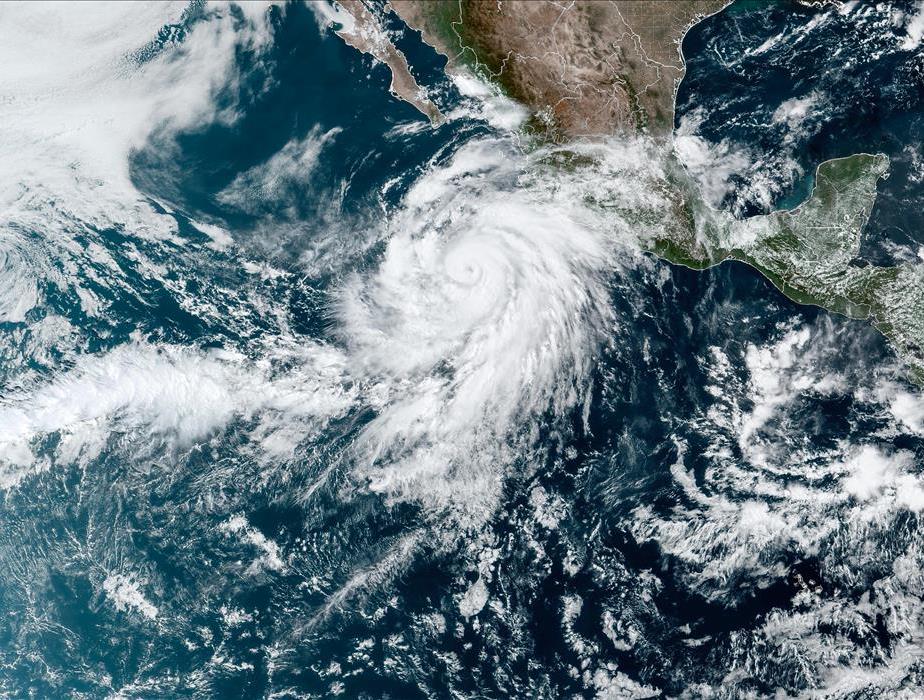
Stay Informed: Monitor reliable sources of weather information, such as the National Hurricane Center (NHC) or your local meteorological agencies. They will provide updates and forecasts on the storm's track, intensity, and potential impacts.
Emergency Kit: Create an emergency kit that includes essential supplies such as non-perishable food, water, medications, first aid supplies, flashlight, batteries, a battery-operated radio, and personal hygiene items. Plan for at least three days' worth of supplies.
Evacuation Plan: Know your evacuation routes and have a plan in place for where you'll go if you need to evacuate. Stay informed about evacuation orders from local authorities.
Secure Your Property: Trim trees and shrubs around your property to minimize the risk of flying debris. Secure loose outdoor items that could become projectiles in strong winds.
Protect Windows and Doors: If you're in an area prone to hurricanes, consider installing storm shutters or boarding up windows and doors with plywood to protect against flying debris.
Important Documents: Keep important documents, such as identification, insurance policies, medical records, and financial documents, in a waterproof container.
Communication Plan: Ensure that you have a way to communicate with family members in case you get separated. Have a designated point of contact outside the affected area who everyone can check in with.
Fuel and Transportation: Keep your vehicles fueled up and in good condition. Gas stations might be closed or busy during an emergency.
Medication and Medical Supplies: If you have prescription medications or medical equipment, ensure you have a sufficient supply on hand. Keep a list of your medications and dosages.
Pets and Livestock: If you have pets or livestock, make sure you have a plan for their care, including food, water, and shelter.
Secure Important Items: Move valuable or sentimental items to higher ground or a safer location in case of flooding.
Stay Put if Safe: If you're not in a designated evacuation zone and your home is well-built and sturdy, it might be safer to stay put. But always follow local authorities' advice.
Why Clean Up That Water?
8/18/2023 (Permalink)
Excess moisture in your home can lead to a range of problems, both structural and health-related. It's important to manage moisture levels to maintain a healthy and safe living environment. Here are some of the potential issues that moisture can cause in your home:
Mold and Mildew Growth: High moisture levels provide an ideal environment for mold and mildew to thrive. Mold growth can damage surfaces, produce unpleasant odors, and pose health risks, especially to individuals with allergies, asthma, or respiratory issues.
Structural Damage: Moisture can weaken the structural integrity of your home over time. It can cause wood to rot, weaken foundations, corrode metal components, and deteriorate materials like drywall and insulation.
Dampness and Discomfort: Excess moisture can lead to a feeling of dampness and discomfort within your living spaces. This can make your home less inviting and affect your overall quality of life.
Peeling Paint and Wallpaper: Moisture can cause paint and wallpaper to peel or blister, leading to unsightly and deteriorating surfaces.
Water Stains: Water stains on ceilings, walls, and floors are not only unsightly but can also indicate ongoing leaks or moisture issues.
Pest Infestations: Moist environments attract pests such as cockroaches, termites, and silverfish. These pests can cause additional damage to your home and pose health risks.
Allergens and Health Risks: Mold spores and dust mites, both commonly found in moist environments, can trigger allergies and worsen respiratory conditions like asthma.
Foul Odors: Moisture can create musty and unpleasant odors that linger in your home, making it less comfortable for occupants and visitors.
Electrical Hazards: Moisture can damage electrical systems, leading to short circuits, power outages, and potential electrical hazards.
Decreased Energy Efficiency: Moisture can affect the insulation properties of materials, leading to decreased energy efficiency as heating and cooling systems work harder to maintain desired temperatures.
What to Know Before Water Damage Strikes
1/11/2023 (Permalink)
Evaluate the risk of potential water damage.
Homeowners undoubtedly have a responsibility to try and protect against the next loss. More carriers are seeing similar trends regarding water damage recidivism. As a result, some are not renewing homes with multiple water losses, or are requiring the installation of mitigation devices. In a study by the California Department of Insurance, 25% of the companies (surveyed) refused to renew the policies of customers who made one or two non-water damage claims in the past three years. And 32% refused to renew policies for people who made one or two water-loss claims in the past three years2.
Understand your insurance policy. Does it include a flood rider? Most policies need this to be specifically added by the policy holder. If it does, know your coverage. Oftentimes, flood and water damage are not a “total restore” under the policy, meaning that the loss may be covered only up to a percentage. If this is the case, it may be worth speaking with your provider about extending your coverage.
Between hour 2 and the end of the first week, the damage will compound. Your home will experience growth and spread of mold and mildew. The doors, windows, and wood flooring may swell and warp, and metal may begin to rust and corrode. At the same time, there is a possibility of serious biohazard contamination.
What They Don't Tell You About Water Damage!
10/27/2022 (Permalink)
Water damage is a common problem that homeowners face.
Water damage, though not well-understood, is certainly not uncommon. According to statistics from the attorneys at Arguello Hope & Associates, PLLC, 4 in 10 homeowners have experienced some sort of loss from this issue. The same source reported that more than 90% of it is preventable, however.
Yes. Water damage can be one of the most common and most serious emergencies your property can experience. Whether your home has been affected by a storm, flood, roof leak, HVAC leak, busted pipes, overflowing appliances or sewage backup, a water problem can easily distress and threaten you and your home’s safety as well as your property value.
Common costs associated with water damage include replacing flooring and furniture, mold repair and removal, and installing new drywall. Wood beams and other structural elements will often need to be replaced. If the home must be gutted and re-done, the costs can be astronomical — which is why having a comprehensive homeowner’s insurance plan is a good idea.
Water damage can cause extensive damage to property.
The damage may be imperceptibly slow and minor such as water spots that could eventually mar a surface, or it may be instantaneous and catastrophic such as burst pipes and flooding. However fast it occurs, water damage is a major contributor to loss of property.
Water damage can ruin your electrical system. We all know water and electricity don’t play well together. Water damage left unattended too long can cause electrical shorts and damage to your circuits. Can you say fire hazard? The less damage the better, so staying on top of water damage cleanup is a must.
Water damage affects buildings on so many levels. When water creeps into areas of your property where it shouldn’t be, your floor could warp. Water damage also discolors beautifully painted walls. All that moisture can also lead not only to the formation of mold inside the building but also to a vermin infestation. Worst of all, water damage that isn’t immediately addressed through water damage restoration could eventually weaken the foundation of any building.
Water damage can be disastrous and costly.
The fact of the matter is that the longer you leave water damage, the more it’s going to cost to repair. Fixing the problem right away could be relatively quick and easy, but if you leave it, it could just get worse and worse. When you do finally take care of it, you could end up paying much more than you should have.
Call us at SERVPRO of South Lake Forest/ Laguna Woods to schedule an inspection of your property today.
The Potentialities of Water Damage
9/14/2022 (Permalink)
Although not well-discerned, water damage is certainly not uncommon. Generally, this issue can be defined as water that dismantles the interior of your home or business. It can be a result of the following:
? A hailstorm shatters your windows and gets your floors wet.? An overflowing bathroom that damages your floors.? Rain penetrates your roof and destroys the ceiling and walls.? A cracked pipe that saturates your ceiling.If your home or business has this kind of damage, the first thing to do is review your homeowner’s insurance. Also, consider re-evaluating the individual policy for the specifics of your circumstance. Note that accidental events will be catered for, but any destruction caused by negligence will be neglected as well. There is also a distinction between flood damage and water damage. While the overall root of the two issues is similar, they are monumentally distinct. For instance, flood often meets conditions such as rapid accumulation of surface waters from any source, mudflow, and an overflow of inland or tidal waters. Water damage, on the other hand, happens before the water comes in contact with the ground.
Even in grave cases, water can grow into something more deleterious if not handled promptly. SERVPRO recommends that you avoid risking addressing experts when it is too late. The restoration process is not all that complicated, and we do everything in our power to make it as perfect as possible. Get in touch today!
A Guide To Confronting Water Damage
8/24/2022 (Permalink)
Immediately you shut down the electricity and water source, you are looking at puddles and contemplating,” What’s next?”. Consider conducting an assessment and plan for a damage repair promptly. Wet materials begin developing profound grave problems like mold after 24 hours. SERVPRO has several successful tips for water damage repair as follows:
1. Know the distinct types of Water-
The first type of water is gray water, moderately dirty water from washing machines, dishwashers, and clean toilets. You can clean it up yourself if you can remove it cautiously and with the right safety gear to protect yourself. The second type is clean water from leaky pipes or rain. This is less harmful and you can clean it yourself or hire a restoration company to deal with the water damages.
2. Assess serious problems like mold-
Inspect damaged items for mildew and mold. Mold grows under the right conditions in as little as 24 hours. If you find mold and mildew problems, you ought to be very cautious. Remember that mold can hide inside walls and under floors, and this is why there is a need for a thorough assessment/inspection.
3. Dry out the affected areas-
It is incumbent to eradicate all moisture swiftly before it causes more damage. You can use fans to circulate air in the affected regions and be thorough about this step. For bigger projects, consider leasing a large-capacity dehumidifier to thoroughly dry out carpets, wood, and materials.
4. Reach out to SERVPRO-
You have handled basic steps autonomously. The next phase involves you reaching out to the best restoration service. Our experts will visit and assess the damage, and negotiate with your insurers to guarantee a smooth restoration process. We will measure and replace dry walls, and inspect and replace external siding, caulk, and paint. Call us at any time, will be there to handle your home or commercial property damages.
A Family’s Water Damage Story
8/2/2022 (Permalink)
When I was in elementary school, my family went out on vacation to Big Bear leaving my older sister behind to watch the house. A real wise decision on my parent’s part, leaving a high schooler an entire home in the suburbs to herself for the week.
The vacation was normal, mediocre at best; it was the events upon arriving home that marked the core memories of my childhood. My sister had flooded the entire house from clogging the upstairs toilet. My mother, enraged, asked “How in the hell did you clog the toilet?!” My sister replied, “I took a really big sh**.” Mind you, my sister was about 5 feet tall and 110 pounds at this time.
Apparently, she sold her case well because my parents believed her. The following weeks went as any water damage restoration job would go.
Technicians came in, assessed the damage, and proposed that nearly the entire house had to be covered in containment material and dried with dehumidifiers.
My younger sister and I at the time would always play in the office room, and that was one of the areas that was sealed off with containment material. The area was still safe to use, but from wall to wall the room was covered in plastic. To my sister and I’s 8 year old minds, this was the perfect scene for a choreographed music video to Rhianna’s song “Shut up and Drive.”
We worked tirelessly coming up with the perfect dance moves and camera angles on our 1080p camera recorder. The environment was a once in a lifetime set up for the perfect pop star moment.
We finished the video and performed it for our parents who sat and watched, pretending we were the greatest stars to ever exist. The video still sits in our family's archives til' this day, a staple in our history.
And what about my older sister? Well, about 10 years later the truth came out. She did not clog the toilet with a massive turd. Rather, she threw the largest rager to ever occur in that suburban town, and masterfully got away with it.
Lesson learned here is that parents, though your children may make costly mistakes, there is always a positive side to every situation, even if it’s as silly as a music video made by your eight year old girls that will forever be one of the best memories kept from their childhood.
Water is Crazy!
7/27/2022 (Permalink)
Water– an essential component to human life. Liquid we depend on to fuel our busy day to day lives. A source of energy. We can appreciate water for all of its benefits and contributions to earthly functioning, but something so fundamental to life has great potential to bombard, destroy, and wash away what it once birthed into dust, like tears in the rain.
It is the elements, those most rudimentary building blocks of matter, that pose a formidable threat to the fruits of human consciousness. Take, for example, the Indonesian Tsunami of 2004. Near 230,000 casualties, this event marks its place as one of the largest and the most detrimental natural disasters in modern history. The waves traveled at 500mph, near the average speed of a jet plane, spreading 5,000 miles from the earthquake's epicenter.
Of course, disasters like these are an inflation of the damage water can wreak on our simple, everyday lives. We have plenty of blogs on SERVPRO of Lake Forest South and Laguna Woods on the potentialities of water damage within the business and home. Small inconveniences like these are a feature of living. But to understand the sheer force of something that shapes into the crevices of the hand when touched is no feature of living, but something sought and discovered. Harness the dynamics of water to behave in your favor. Work at a scale that will benefit you and generate the greatest impact to preserve your way of living.
Categorizing Water Damage
8/2/2021 (Permalink)
When SERVPRO is confronted with a water damage job, there are many things to consider to make sure we move forward with the best plan. One of the things considered is the category of water damage we’re working with. Not all water damage jobs are equal, and each category is met with different precautions and procedures to yield the best outcome. It is also important for you as a homeowner to understand the category of water damage your property is facing to make sure everyone is safe and at a proper distance from any dangerous areas. Here’s some insight on the categories of water damage:
Category 1- Clean Water
These types of situations are leaks and floods of water that are not hazardous. This includes overflowing bathtubs, defective appliances like refrigerators, or a rainwater leak in the home. These are category 1 because the water poses no health risk.
Category 2- Grey Water
Greywater is when the water may contain some pollutants like urine, mold, or dirt that can be of a health risk if exposed to us. Leaks from a washing machine, clogged toilets with only urine, or overflowed aquariums can yield this category of water damage. This type of damage is recommended to be responded to immediately because this water can leave lasting effects on your home if not tended to quickly.
Category 3- Black Water
This type of water damage contains very hazardous contaminants in the water requiring our workers to wear special protective gear to deal with these jobs. Clogged plumbing systems, flood runoff from lakes, oceans, or rivers, and sewer backups are all examples of black water category damage. In the event of this damage, it is imperative that action is taken immediately and everyone is evacuated from the affected areas.
If you are ever confronted with any of these categories of water damage, call SERVPRO of Lake Forest South / Laguna Woods at our emergency service line to get help in making your property “Like it never even happened.” We are here to assist you in unpredicted events like this and will guide you through every step of the way. To learn more about water damage, check out our other blogs.
Handling a Leak From Faulty Kitchen or Bathroom Piping
7/20/2021 (Permalink)
One of the most common forms of damage we deal with here at SERVPRO of Lake Forest South/Laguna Woods is water, be it from external sources like mudslides and accumulated water from a heavy storm, or internal flooding like pipe bursts and clogs. In previous blogs we have covered the steps you as a property owner can take to prevent such disasters, but beyond anyone’s control, the unexpected may occur regardless of your preparation efforts. So, what do you do when confronted with internal piping issues that lead to sudden water build up in your property?
Shut off the Main Water Valve
to cease the flow of water into unwanted areas. As a property owner, you should know the location of the water shut off. If not, call us at (949) 429-3188 and our technicians will guide you through the process of finding and understanding this paramount aspect of your home. We may also equip you with an Emergency Read Plan that denotes all energy supply shut offs on your property along with information on how to work them.
Clear The Area
of all valuable belongings to prevent them from being damaged by the escaping water. In some cases, grey or black water is released into the home introducing a severe level of damage. This type of liquid contains pollutants from your home’s sewage and waste systems that are potentially harmful if brought into close contact with anyone in the surrounding areas.
Call a Restoration Company
like SERVPRO of Lake Forest South/Laguna Woods. We are here 24 hours a day, 7 days a week, even holidays, to assist you with your damage needs. We understand that damage is in most instances extremely unexpected. We will guide you through the process and keep you informed on best practices for avoiding future disasters. It is important that you have the contact information to your home insurance for us to collaborate with adjustors, ensuring damage costs are at an all time low.
Follow these steps to handle internal home flooding with grace, and don’t forget that SERVPRO is here “Faster to any disaster!”
The Reality of Water Damage
7/20/2021 (Permalink)
Are you a property owner with a keen understanding of water damage? It is okay if you cannot answer this question confidently, the typical homeowner is not equipped with an arsenal of information regarding the potential of natural disasters. That is why SERVPRO is here to chart the course for future property owners by providing the education necessary to carefully maintain all types of land and prevent every strain of natural disaster.
Water damage is one of the most formidable and recurrent forms of natural calamity. The majority of our calls pertain to damage of the sort, so familiarizing yourself with the reality of this is paramount to being an efficient property owner.
The most pressing issue on an owner’s mind after suffering from property damage is the monetary cost. Damage is an unforeseen obstacle, and often unaccounted for in one’s finances. This is what insurance is for, to act as a safety net for events that are known to likely happen, but never when, where or to what degree.
The price tag to water damage is determined in the assessment phase, by the equipment needed for the job and the time it will take to completely mitigate the affected areas. A pipe leak that was caught early on causing damage to a fraction of the property will cost considerably less than if an entire house were to flood from a sudden and profuse pipe burst. Leaks in the water supply line tend to burst. This is why we push routine property inspection and damage preparation so potential hazards may be noticed sooner rather than later.
Certain water damage jobs require occupants of the property to relocate during the mitigation process. Water damage is classified under three categories, clean water, greywater and black water. Grey and black water damage is handled with extra care by our technicians and will most likely necessitate temporary relocation from the property. This is for the safety of everyone involved in the process so that any and all damage is contained and properly handled.
These features of water damage are something to think about as a property owner. Know the reality of what you are getting into and how to best prepare yourself to avoid a damaging situation. And if it happens anyways, don't worry, contact us here at SERVPRO using our 24 hour emergency service line (949) 429-3188.
Common Causes of a Dishwasher Leak
7/12/2021 (Permalink)
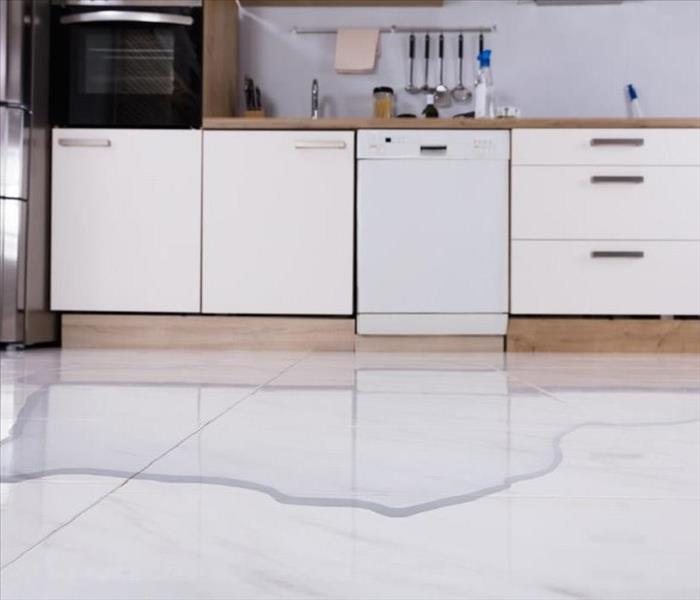 Don't let this happen to your kitchen, read our blogs to learn how to prevent a dishwasher leak!
Don't let this happen to your kitchen, read our blogs to learn how to prevent a dishwasher leak!
What is the most common cause of a dishwasher leaking?
One of the most common reasons a dishwasher might leak is due to a damaged or deteriorated door seal. Also known as a tub gasket, water usually leaks from the lower sides of the door if there is a breach in the seal.
Wrong Dishwasher Detergent
Even if you're rinsing your dishes with soap prior to running them through the dishwasher, the solution on the dishes can bubble up and put pressure against the door seal, causing it to eventually leak. Avoid using dish soap when rinsing dishes to avoid this problem.
This are some of the materials that could be affected by a dishwasher leak:
- Drywall
- Carpet
- Carpet pad
- Insulation
- Baseboards
- Cabinets
- Laminate
It's always better to know what could happen and be prepared for this situation. We hope this information is helpful to everyone. Remember "Like it never even happened."
Call SERVPRO of Lake Forest South/Laguna woods for your water damage at our 24 hour, 7 days a week emergency service line, 949-429-3188.
How Water and Flood Damage Differ
7/1/2021 (Permalink)
Water damage and flood damage are two different things according to the insurance adjusters who handle the liability and coverage of whatever damage scenario is bought to their attention. The difference between them is where the water comes from. Water damage is caused by water entering from inside the home, from the pipes that back your running water outlets. Flood damage is when water comes from a natural source like mudslides, accumulated rain runoff, and overflow of tidal waters. Flood damage also includes two or more properties. The caliber of flood damage is much bigger than that of water damage, which is why insurance adjusters classify it as a different disaster.
Flood damage is not covered by your home insurance, only water damage. Here in California it is less likely for you to experience flood damage, but that doesn't mean it’s impossible. If you live in an area vulnerable to flooding like near the beach or by a hill that is prone to mudslides, it’d be in your favor to discuss with the property owner filing for flood insurance. This can be done at www.floodsmart.gov.
Here at SERVPRO it is in our best interest to keep you updated and informed about how you can best prepare for natural disaster damage. For more information, feel free to give us a call at (949) 429-3188.
Maintain Your Property’s Water Heater to Avoid Severe Water Damage
6/30/2021 (Permalink)
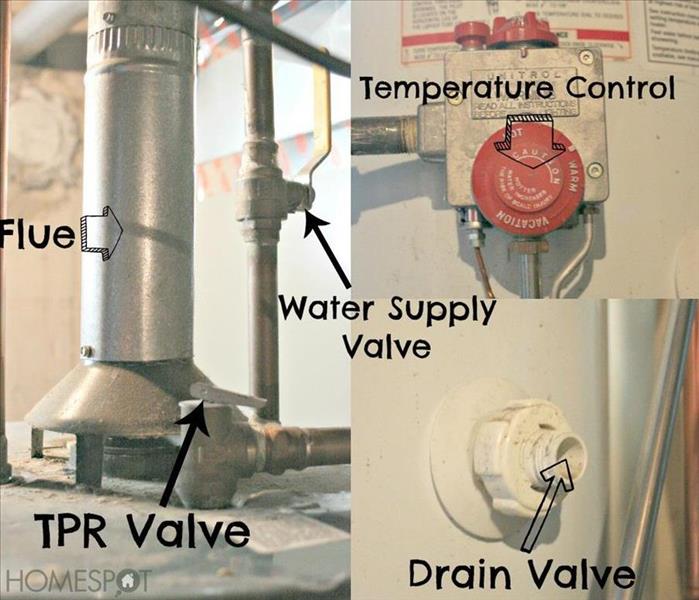 An infographic denoting the various components of a water heater to guide you in the maintenance process
An infographic denoting the various components of a water heater to guide you in the maintenance process
An essential part to being a homeowner is paying great care to the appliances which heat and cool your property’s vital resources. Naturally, heating and cooling units will wear over time or collect build up of some sort depending on the unit’s method of energy transfer. With this in mind, let’s take a look at the different types of water heaters most commonly seen in homes and how to properly maintain them.
It is customary to have a tank water heater that ranges from 30-50 gallons in size, usually stored in the garage, a closet or bathroom. The unit may operate using gas or electricity, but both of these models will have a Temperature and Pressure Relief valve that maintains the movement of water from the unit to the parts of the home that require heated water. Pay heed to this valve; if it is jammed and the property’s tank does not have an emergency shut off valve, the unit will over pressurize causing it to burst or explode. This is the worst case scenario, and why we are here to inform you on the protocols to avoid such a disaster.
Check the valve to your water heater every six months by lifting and releasing the brass lever a few times, making sure that when you do this water is released from the drain pipe. If nothing is released or the stream is weak, consider calling a plumber to replace the valve. A malfunction in the Temperature and Pressure release valve could be due to corrosion or mineral build-up from years of unchecked use.
Flush your water heater once a year to avoid sediment build up that could possibly lead to a Temperature and Pressure valve malfunction. This can be done on your own but forewarning that the water contained in the heater can reach scorching temperatures. If you are not comfortable performing this task, it is in your best interest to call a plumber.
We look forward to helping our clients when given the opportunity, but we also understand what circumstances led you to call in the first place. It is always best to avoid damage, and to do that is with careful maintenance of your property. If you suspect a feature of your home is not functioning up to par, call us at (949) 429-3188 to schedule an inspection. For more property maintenance tips, read our blogs.
Water damage problems
1/24/2020 (Permalink)
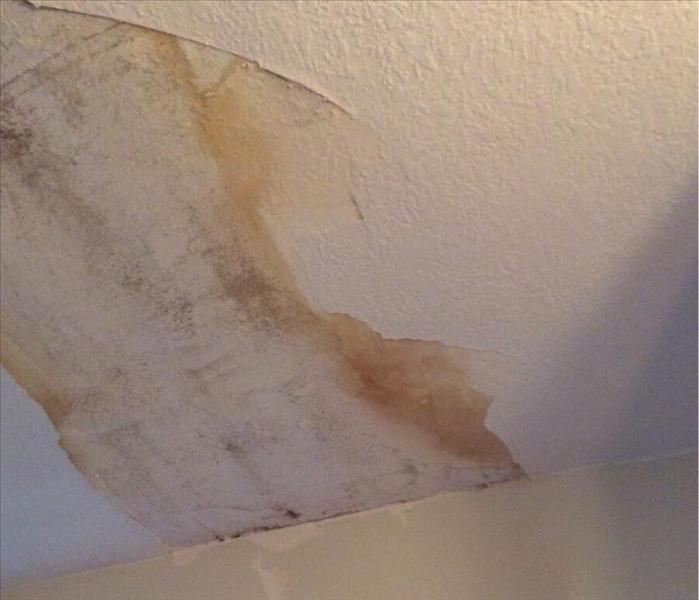 This is a ceiling with water damage.
This is a ceiling with water damage.
Water Damage Causes
- Bursting or leaking pipes.
- Issues with the plumbing system.
- Buildup in areas prone to collecting water, such as crawl spaces, attics and basements.
- Faulty or malfunctioning household appliances.
- HVAC (Heating, ventilating and air conditioning units) issues.
- Natural disasters and other weather-related water problems.
How long does it take for water damage?
Within 1 to 24 hours – When water damage lasts for 1 to 24 hours, drywall begins to bulge and break, furniture begins to swell and crack, and metal surfaces begin to tarnish. Within 2 hours to 7 days – You will experience growth and spread of mold and mildew.
On a situation of water damage, we are here 24 hours a day to take care of any size of damage. Whether you simply have a question about something you're dealing with at your property or you require immediate assistance, SERVPRO of Lake forest South/Laguna Woods is always "here to help"
Tips to avoid water damage to your home
1/24/2020 (Permalink)
How can I protect my house from water damage?
- Disconnect Hoses
Standing water in a hose may freeze back into the pipe and create an ice block that – in a best-case scenario – stops your water flow and, worst case, may bust your pipes and create damage to walls, floor and foundation.
- Maintain Trees and Vegetation
Thriving shrubs can be a beautiful thing – except when their roots wrap around your pipes and break them. That’s why it’s important to minimize landscaping near utility pipes or, if necessary, remove trees and shrubs that have become too big.
- Know your Water Main
Know the location of your water main and shut it off if you leave for an extended amount of time. If no water goes into the house, chances are no faucet drips can wreak havoc on your home!
- Check Appliances Regularly
Check and maintain your appliances regularly for leaks according to manufacturer’s directions.
- Investigate Leaks Right Away and Fix Promptly
If you opt to ignore moisture damage, or postpone making the necessary repairs, be prepared to experience mold, mildew, dry rot, or even structural damage to your home.
- Upgrade Washing Machine Hoses
Old, brittle or leaky washing machine hoses are among the most frequent causes of water loss for homeowners. Replace yours regularly to avoid a mighty mess and expensive damage.
- Install Water Detection Devices
A water detector is a small electronic device that sounds an alarm when its sensor is in contact with moisture. Its main benefit is that it detects low moisture levels or slow leaks that often go unnoticed. Install it near water heaters, sump pumps, washing machines, dishwashers and toilets to prevent extensive damage and mold growth.
- Monitor Your Water Bill
Sometimes, the only way you know that water is leaking is taking a closer look at your water bill. If your usage jumps significantly from one month to the next without explanation, put your “water detective’s hat” on. Is there a leak in your crawlspace? Or, is it a pipe in your front yard? Don’t leave mystery leaks unattended!
Follow these tips to keep your home safe and well-maintained, call SERVPRO of Lake Forest South/Laguna Woods for any type of inspection.
Water pipe leak
1/24/2020 (Permalink)
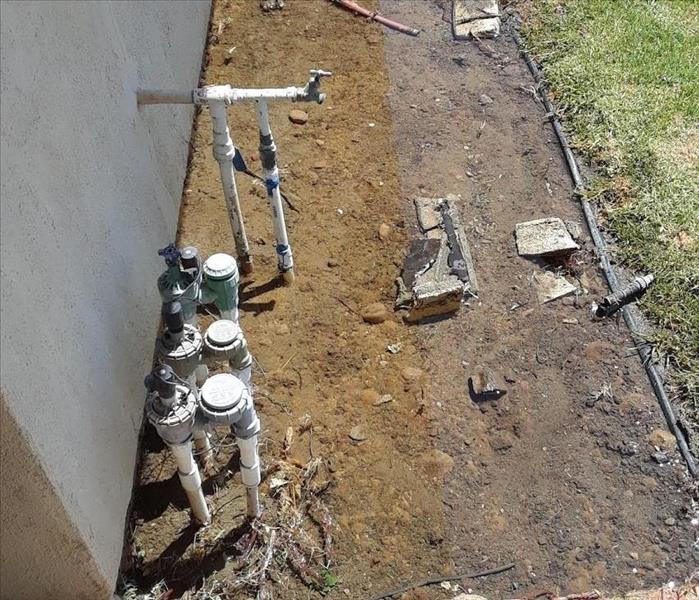 This is a water leak from a pipe.
This is a water leak from a pipe.
Why do water pipes leak?
These temperature changes within the pipe might cause some pipes to burst or crack leading to leakages. Some pipes freeze during winter and contract, when water runs through them, the expansion causes crevices to form which in time lead to leaks.
What to do if water pipe is leaking?
For tiny leaks in pipes, use a compound stick available at most hardware stores. Simply rub the stick over the hole to stop the leak. The compound stick can even stop small leaks while the water is still running in the pipe. Epoxy paste can be applied only to dry pipes, and the water must be turned off.
Here at SERVPRO of Lake Forest South/Laguna Woods our Technicians are knowledgeable and well trained to handle any situation. “Like it never even happened.”
What to do on a roof leak situation
1/17/2020 (Permalink)
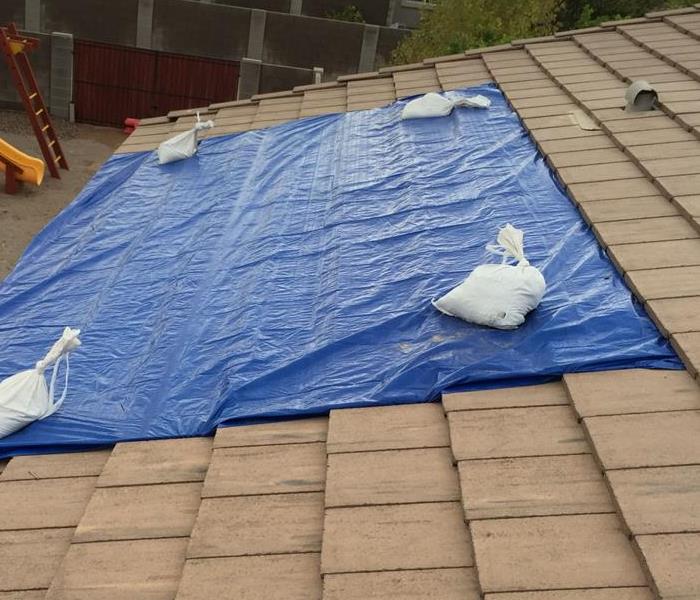 This is roof leak with a tarp.
This is roof leak with a tarp.
What Do You Do if Your Roof a spring Leak?
- Stop the water damage, once you discover an active leak in your roof, the first thing to do is minimize the water damage as much as possible.
- Contain the water
- Remove the water
- Call your insurance company
- Fix the roof leak
Is a leaking roof an emergency?
Roof leaks are a problem in any weather, but a roof that starts to leak during a heavy rainstorm can quickly turn into a major emergency. Unfortunately, rainy weather is when a roof leak is most likely to happen.
On a situation of water damage, we are here 24 hours a day to take care of any size of damage.Just remember SERVPRO, it’s here ready to help, "Like it never even happened."
What are the signs of water on walls?
1/7/2020 (Permalink)
The following are common signs of water leakage behind your walls.
- Musty odors.
- Visible mold growth on walls and baseboards.
- Staining.
- Peeling or bubbling paint and wallpaper.
- Warped walls.
- Buckled ceilings and floors.
- High Utility Bills
What happens when water gets in your walls?
Excess water and moisture gets absorbed in wood, drywall, insulation, and wallpaper which can lead to warping, stains, bubbling, and deterioration. Hidden water leaks can also cause mold to grow and spread in areas behind walls and ceilings where it is not easily detected.
These are a few of the most common signs of water on walls that can affect your home in the case of water damage. For every job we inspect these things to get a thorough understating of your property’s water damage situation so we can create a plan to make your home/commercial property “Like it never even happened.”
Why do my windows leak when it rains?
1/7/2020 (Permalink)
Most often window leaks during rain are the result of faulty installation or improper construction. It could also be a lack of overhangs or improperly angled fascia that drain water and protect against wind-driven rain. Or leaks could be the result of poor maintenance or missing caulking.
How window leaks could affect your home?
Window leakage is more than just annoying—it can cause damage to your home, including mold and mildew growth, wood rot, or even foundation problems! Never ignore leaky windows. If you notice water around your windows after it rains, you should consider having your windows repaired or replaced. If you don’t notice right away water coming in, it could damage some of the following materials:
- Drywall
- Carpet
- Carpet pad
- Insulation
- Baseboards
- Cabinets
- Laminate
Its always best to repaired before it gets worst and materials are affected. If your property has water damage, it’s best to call a water damage restoration company instead of fixing the mess yourself. The professionals will handle everything and leave your house as it was before the damage.
Call SERVPRO of Lake Forest South/Laguna woods for your water damage at 949-429-3188.
How common are slab leaks?
1/7/2020 (Permalink)
Perhaps the most common cause of slab leaks is improperly installed or poor-quality pipes. If your water pipes were kinked, bent, or dented in any way during installation, the affected areas could cause the pipes to leak and potentially burst because of the abrasive properties of water flowing by over time.
What happen when a slab leak occurs?
A slab leak occurs when the pipes inside or underneath a home's foundation begin to leak. If left unattended, slab leaks can saturate the soil under your home, making your floors uneven and slowly sinking the building into the ground.
How bad is a slab leak?
Slab leaks can and will cause: Damage to your home's foundation. Slab leaks can weaken the structural integrity of the concrete and steel supports that comprise your foundation. Eventually, water pressure and leakage can cause you foundation to shift and move.
What are the signs of a slab leak?
- A sudden, unexplained spike in water bills.
- Water pooling where it shouldn't.
- Damp carpet or warped hard flooring.
- Mold or mildew (visible or just the smell)
- A decrease in water pressure.
- A hot water heater that's constantly running.
- Areas of the floor that are suddenly hot.
Repining the whole home or line is the best solution for repairing the slab leak and preventing future slab leaks. The plumber can terminate the leaking line, or all lines, running underneath the slab foundation and put in all new copper water lines.
SERVPRO of Lake Forest South/Laguna Woods always strives to make each customer happy with the service they receive.
DO YOU HAVE A WATER EMERGENCY? CALL US AT 949-429-3188
Water Pipe Leak
12/6/2017 (Permalink)
DO YOU HAVE A WATER EMERGENCY SITUATION? CALL US 24/7 AT 1-800-SERVPRO
SERVPRO of Lake Forest South/Laguna Woods responded to a home located in Mission Viejo. The caller was concerned about running water that they heard between a kitchen and a bathroom wall. Upon arriving at the site, the SERVPRO technicians were able to see water leaking into the kitchen area.
Inspection revealed that there was mold present. When mold is discovered, containments are built to reduce the spread of mold spores in the home. Very specific procedures are completed when dealing with mold such as removal of drywall, sanitation of surrounding materials and air purification.
The customer was pleased with the service provided to her, citing her appreciation for the knowledgeable, well trained, and professional crew that handled her situation.






 24/7 Emergency Service
24/7 Emergency Service


